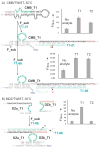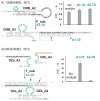Divide and Control: Comparison of Split and Switch Hybridization Sensors
- PMID: 29372178
- PMCID: PMC5777618
- DOI: 10.1002/slct.201701179
Divide and Control: Comparison of Split and Switch Hybridization Sensors
Abstract
Hybridization probes have been intensively used for nucleic acid analysis in medicine, forensics and fundamental research. Instantaneous hybridization probes (IHPs) enable signalling immediately after binding to a targeted DNA or RNA sequences without the need to isolate the probe-target complex (e. g. by gel electrophoresis). The two most common strategies for IHP design are conformational switches and split approach. A conformational switch changes its conformation and produces signal upon hybridization to a target. Split approach uses two (or more) strands that independently or semi independently bind the target and produce an output signal only if all components associate. Here, we compared the performance of split vs switch designs for deoxyribozyme (Dz) hybridization probes under optimal conditions for each of them. The split design was represented by binary Dz (BiDz) probes; while catalytic molecular beacon (CMB) probes represented the switch design. It was found that BiDz were significantly more selective than CMBs in recognition of single base substitution. CMBs produced high background signal when operated at 55°C. An important advantage of BiDz over CMB is more straightforward design and simplicity of assay optimization.
Keywords: Catalytic molecular beacons; Deoxyribozyme sensors; fluorescent sensors; instantaneous hybridization probes; single nucleotide polymorphisms; split hybridization probes.
Conflict of interest statement
Conflict of Interest The authors declare no conflict of interest.
Figures



Similar articles
-
Expedited quantification of mutant ribosomal RNA by binary deoxyribozyme (BiDz) sensors.RNA. 2015 Oct;21(10):1834-43. doi: 10.1261/rna.052613.115. Epub 2015 Aug 19. RNA. 2015. PMID: 26289345 Free PMC article.
-
Evolution of Hybridization Probes to DNA Machines and Robots.Acc Chem Res. 2019 Jul 16;52(7):1949-1956. doi: 10.1021/acs.accounts.9b00098. Epub 2019 Jun 20. Acc Chem Res. 2019. PMID: 31243970
-
Toward a Rational Approach to Design Split G-Quadruplex Probes.ACS Chem Biol. 2019 Dec 20;14(12):2701-2712. doi: 10.1021/acschembio.9b00634. Epub 2019 Oct 22. ACS Chem Biol. 2019. PMID: 31599573 Free PMC article.
-
Single-Labeled Oligonucleotides Showing Fluorescence Changes Upon Hybridization with Target Nucleic Acids.Molecules. 2018 Jan 8;23(1):124. doi: 10.3390/molecules23010124. Molecules. 2018. PMID: 29316733 Free PMC article. Review.
-
Real-time assays with molecular beacons and other fluorescent nucleic acid hybridization probes.Clin Chim Acta. 2006 Jan;363(1-2):48-60. doi: 10.1016/j.cccn.2005.04.037. Epub 2005 Aug 18. Clin Chim Acta. 2006. PMID: 16111667 Review.
Cited by
-
FaptaSyme: A Strategy for Converting a Monomer/Oligomer-Nonselective Aptameric Sensor into an Oligomer-Selective One.Chembiochem. 2018 Apr 26:10.1002/cbic.201800017. doi: 10.1002/cbic.201800017. Online ahead of print. Chembiochem. 2018. PMID: 29700982 Free PMC article.
-
Splitting aptamers and nucleic acid enzymes for the development of advanced biosensors.Nucleic Acids Res. 2020 Apr 17;48(7):3400-3422. doi: 10.1093/nar/gkaa132. Nucleic Acids Res. 2020. PMID: 32112111 Free PMC article. Review.
-
A self-assembling split aptamer multiplex assay for SARS-COVID19 and miniaturization of a malachite green DNA-based aptamer.Sens Actuators Rep. 2022 Nov;4:100125. doi: 10.1016/j.snr.2022.100125. Epub 2022 Nov 5. Sens Actuators Rep. 2022. PMID: 36373144 Free PMC article.
-
DNA Nanomachine (DNM) Biplex Assay for Differentiating Bacillus cereus Species.Int J Mol Sci. 2023 Feb 24;24(5):4473. doi: 10.3390/ijms24054473. Int J Mol Sci. 2023. PMID: 36901903 Free PMC article.
-
Toward a Home Test for COVID-19 Diagnosis: DNA Machine for Amplification-Free SARS-CoV-2 Detection in Clinical Samples.ChemMedChem. 2022 Oct 19;17(20):e202200382. doi: 10.1002/cmdc.202200382. Epub 2022 Sep 15. ChemMedChem. 2022. PMID: 36031581 Free PMC article.
References
Grants and funding
LinkOut - more resources
Full Text Sources
Other Literature Sources
